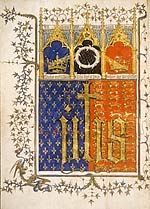sources » Isabelle of France
Isabelle of France
Marriage to Richard II
Isabelle of France (1389-1409), oldest daughter of King Charles VI, was not quite seven years old when she married Richard II as his second wife in 1396. He seems to have been very kind to her. In the Middle Ages princely and aristocratic marriages were often contracted on behalf of young children for reasons of diplomacy or for other material advantages. Canon law, however, decreed that such marriages should not be consummated until both parties were of age, at least twelve for a girl and fourteen for a boy.

Philippe de Mézières, Epistre au roi Richart (London, British Library, Royal MS 20 B. vi, f. 1v)
On 4 November, immediately after the meeting at Ardres, where the twenty-eight year truce between England and France was sealed, the marriage ceremony was solemnised at nearby Calais. The alliance was intended to ensure peace between England and France, an outcome desired by both kings, although not by all their subjects (see Lords Appellant). A beautiful illuminated manuscript, the Letter to King Richard by Philippe de Mézières, advocating peace, recommending the marriage, and exhorting Richard to go on crusade, was sent from Paris on behalf of Charles VI in advance of the marriage. It is now in the British Library, a very rare example of a book which can be traced continuously among the books of the English royal collection from the late fourteenth century onwards.
Return to France
After Richard's deposition in 1399 and his death in 1400, Isabelle remained for some time in England, surrounded by her own small household, a pawn in a political game, in spite of her father's wish for her return. The French ambassadors had great difficulty in gaining access to her. In August 1401 she at last sailed for France. In 1406 Isabelle married her cousin, the poet, Duke Charles of Orléans, but she died in childbirth in 1409.
Isabelle's trousseau
Almost all the many valuables Isabelle brought with her in her trousseau to England can be recognised in the treasure roll by comparing it with the official French record of the objects handed over at Calais immediately after the marriage. There were two exquisite crowns, chaplets and other headdresses, collars (that is ornate necklaces), brooches and other very rich jewels. Besides gold and silver vessels for Isabelle's chamber and chapel, her dolls came with their miniature silver furnishings.
A few losses from the trousseau are recorded in the treasure roll: a white belt with a gold buckle, and a gold brooch with a balas rubybalas ruby - rose-red variety of spinel ruby and pearls. The brooch disappeared at Eltham, where the court spent Christmas and New Year 1396. Two jewelled clasps, also from the trousseau, were given to Richard II at Woodstock and at Nottingham.
Other jewels and plate
Isabelle's French governess, Madame de Courcy, French sources claim, was dismissed just before Richard left for his second expedition to Ireland. The chronicle known as the Traison et mort suggests that this was on grounds of her extravagance. Madame de Courcy was blamed in the roll for gems lost from objects while they were in her charge. Her name attached to entries allows us to identify some of Isabelle's other jewels, not part of her trousseau. A diamond was missing from a collar of fern which had probably once belonged to Anne of Bohemia, a sapphire from a headdress. Two gold harts, Richard II's badge, had also lost gems while in Madame de Courcy's charge. A sapphire and a pearl disappeared from one hart, worth £20. From the other, which was set with a true ruby and exceptionally valuable at £300, a balas ruby was lost at Rockingham in Northamptonshire.
R 346 Item, j cerf d'or garnisez d'un rubie, iij balaces et xviij grosses perlez, dont j balace perdu a Rokyngham en la garde la dame de Courcy, priz par estimacion,, iijc li.
[Item, a hart set with a ruby, three balas rubies and eighteen large pearls, one balas ruby lost at Rockingham in the charge of the dame de Courcy, estimated value, £300.]
Valuables returned to France or retained
The marriage treaty had stipulated that if the marriage was unconsummated Isabelle's dowry and jewels should be returned to France. The instalments of her dowry which had already been received were never repaid. Almost all the jewels and plate from her trousseau were returned in 1401, but not the other splendid gifts she had received from the English and French at the time of her marriage and at New Year from 1396 to 1399.
In recognition of their kinship, Charles VI and Isabeau of Bavaria, Isabelle's mother and father, and her uncles, the Valois dukes, especially Philip of Burgundy and John of Berry, sent magnificent gifts to Richard II and Isabelle for New Year from 1397 to 1399. Some of these splendid objects can be recognised in the treasure roll (see St Edward the Confessor and St Edmund for an example). Some can be traced, still in English royal possession under the Lancastrian kings in the fifteenth century.
